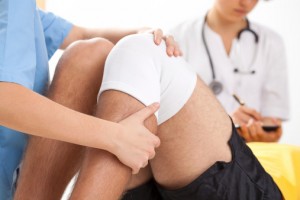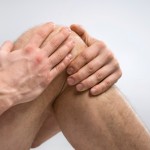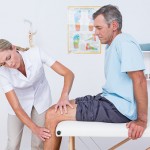

 A meniscus tear is a painful knee injury categorized by pain, swelling and stiffness, which can be influenced by body mass index (BMI) and obesity. A torn meniscus is a tear in the cartilage located on top of the tibia, which allows the femur to glide during knee movement. An MRI or knee arthroscopy will be able to determine what kind of tear it is (lateral or medial) and where it is located.
A meniscus tear is a painful knee injury categorized by pain, swelling and stiffness, which can be influenced by body mass index (BMI) and obesity. A torn meniscus is a tear in the cartilage located on top of the tibia, which allows the femur to glide during knee movement. An MRI or knee arthroscopy will be able to determine what kind of tear it is (lateral or medial) and where it is located.
Blood is transferred differently all over the knee, so locating the exact spot where the tear is can help determine healing time and whether or not surgery is required. If the area where the tear is has a high supply of blood, recovery time will be lessened. After the age of 40 blood supply to this area of the knee becomes reduced and healing from a torn meniscus takes longer.
 Research has found that having a higher body mass index (BMI) or being obese can increase the risk of a torn meniscus. The research included 515 patients who underwent surgery for a torn meniscus. These patients were compared to 9,994 frequency-matched control patients.
Research has found that having a higher body mass index (BMI) or being obese can increase the risk of a torn meniscus. The research included 515 patients who underwent surgery for a torn meniscus. These patients were compared to 9,994 frequency-matched control patients.
Overweight patients – with a BMI over 25 – were three times more likely to have suffered a meniscus tear than their control counterparts who were not overweight. Obese patients – with a BMI over 40 – had a 15 times higher risk of meniscus tear in men and a 25 times higher risk in women.
Based on their findings the researchers estimated that meniscus surgeries were done primarily on individuals who were overweight or obese – 450,000 of 850,000 surgeries.
Study researcher Dr. Kurt T. Hegmann said, “Since 57.4% of the U.S. adult population, or 164 million people, is either overweight or obese, this relationship has potentially large implications for meniscal surgeries. There’s a potential savings of $1.3 billion in the costs associated with meniscus tears in overweight and obese people.”
A meniscus tear most commonly occurs during activity, specifically activities that enable the knee to twist or rotate. Some examples of activities that call for these types of movement are basketball, football, soccer and tennis.
A meniscus tear is most common in children, but can occur at any age. Over time the meniscus can become weaker, increasing the risk of a tear. Furthermore, if you have other conditions, such as osteoarthritis, you are even more prone to a meniscus tear. Therefore, meniscus tears in older adults are more commonly associated with degeneration of cartilage and not with activity or sports.
 Symptoms of a meniscus tear include:
Symptoms of a meniscus tear include:
Exercise can be an effective way to manage a meniscus tear. However, you should speak with your doctor or physiotherapist first because exercise can also contribute to more damage.
Here are some effective exercises that can aid in the recovery of a meniscus tear.
Quad set: While sitting on the floor, extend the leg with the affected knee in front of you. Tighten the quad muscles by pressing the back of the knee flat. Hold this position for six seconds and then release.
Straight-leg front raise: Lay on your back, keeping your healthy knee bent, foot on the floor and your injured knee extended. Simply raise the injured leg and then bring it back down. When the leg is in the air hold it for five seconds before bringing it back down.
Straight-leg back raises: Lay flat on your stomach. Lift your injured leg upwards and hold it in the air for five seconds and then release it back down.
 Hamstring curls: Still on your stomach, instead of lifting the leg you’re going to bend at the knee to make a 90 degree angle and then release the foot back down to the floor.
Hamstring curls: Still on your stomach, instead of lifting the leg you’re going to bend at the knee to make a 90 degree angle and then release the foot back down to the floor.
Heel raises: Holding onto a chair or wall for support, roll onto your toes, lifting your heel and then releasing it down again.
Shallow standing knee bends: While still holding onto the chair or wall, stand straight and begin to slowly bend at the knees as if you are about to sit down. Come down about six inches and then raise yourself back up to a standing position.
The size and location of the tear will greatly determine treatment options. Age, activity level and related injuries, too, also affect the course of treatment. Areas with a good blood supply will heal much quicker and often do not require surgery unless the tear is severe. In areas where blood supply is limited, healing can take longer and the odds of surgery are much greater.
Some treatment options include:
Prevention tips to avoid a meniscus tear include:
By following these tips you can help your knees stay safe and strong, avoiding a meniscus tear and the complications that come along with injury.
Weight loss protects knee, MRI study
MRI studies have revealed that substantial weight loss can significantly lower degeneration of knee cartilage in individuals who are overweight or obese. Obesity is a risk factor for osteoarthritis, a condition where degeneration of joints occurs. The knees are commonly affected by osteoarthritis. Continue reading…
Osteoarthritis knee pain reduced by walking 6,000 or more steps daily
Osteoarthritis can cause knee pain, but combating that knee pain may be as easy as walking. The older we get the more it seems our joints start to hurt. All the years of being active finally catch up with us and pain starts to set in. In particular, it seems that our knees take the heaviest hit. Continue reading…
Copyright © www.orthopaedics.win Bone Health All Rights Reserved